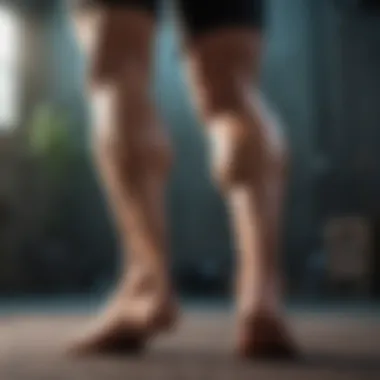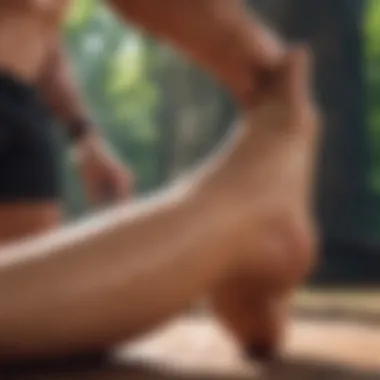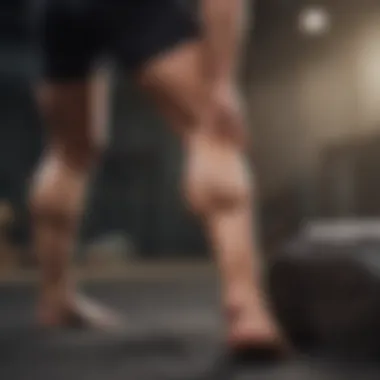Comprehensive Guide to Stopping Calf Muscle Cramps


Intro
Calf muscle cramps are a common yet often painful experience for many individuals, especially those engaged in extreme sports or rigorous physical activities. Understanding the underlying causes of these cramps is crucial to both preventing and alleviating their impact. This section outlines the key aspects that will be explored in the article, providing a roadmap for readers seeking effective methods to manage calf cramps.
Understanding Calf Muscle Cramps
Muscle cramps occur due to involuntary contractions of the muscles, often associated with fatigue, dehydration, or mineral imbalances. In extreme sports, the added strain on the body increases the likelihood of calf cramps. This article will delve into causes, practical prevention strategies, and effective relief techniques tailored to the needs of adventure seekers.
Causes of Calf Muscle Cramps
Cramps can arise from several factors, including:
- Dehydration: Loss of fluids can lead to muscle cramps.
- Overexertion: Pushing the body beyond its limits can induce cramps.
- Nutrient Deficiency: A lack of electrolytes like potassium and magnesium can trigger cramps.
Understanding these causes is essential to develop appropriate prevention and relief strategies.
Prevention Strategies
Preventing calf muscle cramps is possible with proactive measures. This article will address:
- Staying hydrated before, during, and after physical activity.
- Incorporating stretching and warm-up exercises into routines.
- Ensuring proper nutrition to maintain electrolyte balance.
Relief Techniques
When cramps do occur, knowing how to address them immediately is vital. Methods to be discussed include:
- Gentle stretching of the affected muscle.
- Applying heat or cold compresses.
- Hydration and electrolyte replenishment.
By grasping these elements, readers can better navigate the complexities of calf muscle cramps and take informed actions to mitigate their effects.
Understanding Calf Muscle Cramps
Understanding calf muscle cramps is essential for individuals who lead active lifestyles, particularly those engaged in extreme sports. A clear comprehension of the mechanisms behind these cramps enables athletes to identify their causes and implement effective prevention strategies. It also aids in immediate response during incidents of cramping, which can minimize discomfort and potentially reduce the impact on performance.
Definition of Calf Muscle Cramps
Calf muscle cramps are defined as involuntary and forcibly contracted muscles in the calf area. These cramps typically occur suddenly and can last from a few seconds to several minutes. The pain associated with these cramps can be quite severe, causing individuals to halt their activities. This muscle group includes both the gastrocnemius and soleus muscles, which play a crucial role in various movements like walking, running, and jumping. Understanding this definition sets the stage for recognizing when and why these cramps might occur, facilitating timely intervention.
Physiology of Muscle Cramps
The physiology of muscle cramps involves complex neuromuscular interactions. When a calf muscle cramp occurs, the motor neurons discharge excessively, causing muscle fibers to contract without relaxation. This dysregulation can result from a variety of factors, including electrical imbalances, dehydration, or metabolic changes in the muscle tissue. The muscle contraction manifests as a tight sensation, creating a sharp pain that can interfere with movement. By understanding the physiological factors involved, athletes can better prepare themselves for the possible onset of cramps and formulate strategies to mitigate risks.
This knowledge not only informs the athletes of their body’s responses but also empowers them to make educated choices regarding their training regimens and recovery protocols.
Common Causes of Calf Muscle Cramps
Understanding the common causes of calf muscle cramps is crucial for anyone involved in physical activities. Knowledge of these factors can help in prevention and effective management. Each cause presents unique challenges, and recognizing them can mitigate the risk of experiencing painful cramps.
Dehydration and Electrolyte Imbalance
Dehydration is a leading cause of muscle cramps, especially in physically demanding environments. When the body loses fluids, it also loses essential electrolytes like sodium, potassium, and magnesium. These electrolytes are necessary for normal muscle function. Inadequate levels can disrupt the muscle's ability to contract and relax. Athletes, particularly those who engage in extreme sports, must maintain hydration to prevent cramps.
To stay well-hydrated, consider the following practices:
- Drink water before, during, and after exercise.
- Consider electrolyte-replenishing drinks during prolonged activities.
Overexertion and Fatigue
Overexertion is another significant contributor to calf muscle cramps. Pushing the body beyond its limits can lead to muscular fatigue and cramping, especially in high-stress environments. It is important not only to recognize one’s limits but also to train gradually. Suddenly increasing the intensity or duration of workouts can put undue stress on the calves, leading to painful contractions. Appropriate training regimes and breaks can reduce the risk of overexertion.


Here are some tips to manage training intensity:
- Incrementally increase the duration and intensity of workouts.
- Listen to your body; rest when needed.
Poor Circulation
Poor circulation can restrict blood flow to the calf muscles. Insufficient blood supply can lead to oxygen deprivation, increasing the likelihood of muscle cramps. This is particularly relevant for individuals who may already have underlying vascular conditions or those who sit for long periods.
To improve circulation, consider these actions:
- Engage in regular physical activity to enhance blood flow.
- Avoid sitting or standing in one position for too long; change positions frequently.
Muscle Strain or Injury
Previous muscle injuries or strains may predispose individuals to cramps. When muscles are not adequately healed or are subjected to stress, the chances of cramping increase. In many cases, inadequate warm-up before activity can exacerbate this issue. It is vital to adhere to thorough warm-up routines and incorporate time to recover after intense activity.
Here are some preventive measures for musculoskeletal health:
- Include stretching and strength exercises in your routine.
- Gradually ease back into physical activities after an injury.
Being aware of these common causes can inform better training and recovery practices, reducing the occurrence of calf muscle cramps for adventure seekers and extreme sports enthusiasts.
Risk Factors for Calf Muscle Cramps
Understanding the risk factors for calf muscle cramps is crucial for addressing and preventing these painful episodes. Various elements contribute to the likelihood of experiencing cramps. Being aware of these can help individuals, especially those engaged in extreme sports or physically demanding activities, to take preventive measures. This section focuses on three significant risk factors that can influence the occurrence of calf muscle cramps: age and fitness level, chronic medical conditions, and improper footwear.
Age and Fitness Level
As individuals age, their muscles may become less flexible and more prone to cramps. Changes in muscle mass, strength, and overall fitness level can contribute to this increased vulnerability. Older adults may find themselves dealing with more frequent cramps due to factors such as reduced physical activity or pre-existing conditions. Moreover, highly active individuals may push their muscles to the limits, especially during intense exercise. It is essential for athletes to pay attention to their body’s signals and incorporate appropriate stretching and strength training routines to mitigate these risks.
Chronic Medical Conditions
Certain chronic medical conditions can aggravate the risk of calf muscle cramps. Conditions such as diabetes, hypothyroidism, and circulatory issues can affect muscle function and hydration levels. Additionally, individuals with neurological disorders may find that their muscle control is compromised, leading to a higher incidence of cramps. It is important for individuals with such conditions to manage their respective health issues with the guidance of a medical professional. Regular check-ups to assess muscle health and hydration can play a significant role in reducing the likelihood of cramps.
Improper Footwear
Wearing inappropriate footwear is another contributing factor to calf muscle cramps. Shoes that lack proper support or do not fit well can alter the way one walks and runs, placing extra strain on the calf muscles. High heels or shoes with inadequate cushioning may also lead to imbalances in foot and calf function. Selecting the right footwear that offers proper arch support and cushioning is imperative, especially for those involved in sports or activities that place stress on the legs. Potential shoe options include specialized athletic shoes designed for specific activities, which can provide the necessary support needed for peak performance.
Proper support and fitting of shoes can minimize the risk of calf muscle cramps. This is especially important for active individuals or those with existing health conditions.
In summary, recognizing the risk factors associated with calf muscle cramps can empower adventurers and extreme sports enthusiasts to take control of their physical well-being. By addressing age and fitness level, managing chronic medical conditions, and using appropriate footwear, individuals can significantly reduce their chances of experiencing these debilitating cramps.
Immediate Relief Techniques
Immediate relief techniques are crucial for addressing calf muscle cramps effectively. These techniques provide quick methods to alleviate pain, allowing individuals, especially those involved in extreme sports, to regain their functionality and comfort. Understanding these strategies can greatly enhance your capacity to deal with cramps as they happen, fostering a proactive approach to managing this common issue.
Stretching Exercises
Stretching exercises are one of the first responses you can use when a calf muscle cramp strikes. When the muscle contracts painfully, stretching it allows for the fibers to relax. A simple yet effective stretch involves standing on a step with your heels hanging off the edge. By lowering your heels slowly, you engage the muscle and promote blood flow, facilitating recovery.
Here are steps to perform this stretch:
- Stand on a step or a sturdy surface.
- Let your heels dangle off the back.
- Gradually lower your heels until you feel a stretch in your calves.
- Hold this position for 15 to 30 seconds and repeat as needed.
Make sure to breathe during the stretch. It helps in calming the body while providing a better effectiveness.
Massage Techniques
Massage can serve as an excellent method to ease the discomfort associated with calf cramps. Applying gentle pressure to the cramped area can improve circulation and reduce tension. Using either your hands or a foam roller, work on the affected muscle by kneading and applying firm pressure. Focus on the muscle belly rather than the tendons.


Techniques to Try:
- Hand Massage: Use your fingers to gently rub and knead the calf muscle, moving from the ankle towards the knee.
- Foam Roller: Place a foam roller under your calf and roll slowly backward and forward to release tension.
Regular massage can not only provide relief during cramps but also serve as a preventative measure over time, promoting overall muscle health.
Heat and Ice Application
The application of heat or ice can also significantly assist in relieving calf muscle cramps. Each has its merits depending on the situation. Using heat can help by increasing blood flow to the area, while ice serves to reduce inflammation and numb sharp pain. For immediate relief, start with ice for the first 24 hours post-cramp to help reduce swelling, thaen switch to heat therapy as the acute pain subsides.
Application Steps:
- Ice Therapy: Wrap ice in a cloth and apply for about 15-20 minutes.
- Heat Therapy: Use a warm towel or a heating pad, applying it for around 20 minutes.
Be sure to always place a barrier between the hot or cold source and your skin to prevent burns or frostbite.
Hydration Practices
Hydration practices are essential when it comes to handling cramping in the calf muscles. Many cramps are initiated by dehydration or a lack of electrolytes, making hydration a preventative and immediate relief technique. Drinking fluids rich in electrolytes plays a key role in muscle function.
Key Strategies:
- Regular Fluid Intake: Drink water throughout the day, especially before and after physical activities.
- Electrolyte Drinks: Consider beverages like sports drinks or coconut water that replenish electrolytes, further aiding muscle health.
Consistent hydration is crucial for maintaining optimal muscle performance, particularly in high-intensity sports or activities.
Staying proactive with these immediate relief techniques can significantly help in managing calf muscle cramps effectively.
Preventive Measures for Calf Muscle Cramps
Preventive measures for calf muscle cramps are critical in maintaining muscle health and performance, especially for athletes and active individuals. The focus here is on practical strategies that can reduce the risk of cramps, enabling continued engagement in physical activities without interruptions. Addressing calf cramps before they occur is more efficient than treating them after they begin. Implementing these measures can lead to better overall performance and enjoyment in sports and other physical endeavors.
Staying Hydrated
Hydration is an essential component for muscle function. Water plays a pivotal role in transporting nutrients and removing waste from muscle tissues. When the body is dehydrated, it can lead to muscle cramps. For adventure seekers, maintaining hydration before, during, and after physical activities is crucial. The following tips can assist in ensuring adequate hydration:
- Drink Water Regularly: Aim for at least eight glasses of water daily, increasing intake on active days.
- Include Electrolytes: Add sports drinks or electrolyte powders to replace lost salts during intense exercise. This enhances retention of fluids and muscle function.
- Check Urine Color: Light yellow urine often indicates proper hydration. Darker colors may suggest the need to drink more fluids.
Proper Warm-Up and Cool-Down
Warming up and cooling down may seem basic, but they are vital in preventing calf muscle cramps. A thorough warm-up prepares the muscles for activity. Conversely, a cool-down helps relieve muscle tension post-exercise. Below are recommendations for both phases:
- Dynamic Stretching: Begin with several minutes of dynamic stretches focused on the calves, such as calf raises or ankle circles. This enhances blood circulation and prepares the muscles.
- Gradually Increase Intensity: Start your activities at a slower pace and gradually increase to your target intensity level.
- Static Stretching Post-Exercise: After exercising, engage in static stretching. Hold stretches for 15-30 seconds, concentrating on the calf muscles. This can aid in muscle recovery and flexibility.
Strength and Flexibility Training
Maintaining a balanced strength and flexibility training program contributes significantly to preventing calf cramps. Strong, flexible muscles are less prone to cramping. Here are some strategies:
- Targeted Strength Training: Include exercises like calf raises, lunges, and squats to enhance strength. Focus on both the gastrocnemius and soleus muscles to build overall calf strength.
- Flexibility Exercises: Incorporate yoga or specific stretching routines. This can improve overall muscle flexibility and reduce tension.
- Adopt a Progressive Approach: Increase the frequency and intensity of your workouts gradually to avoid overuse injuries that can lead to cramps.
Implementing these preventive measures can greatly assist those engaged in extreme sports or physical activities by minimizing the risks associated with calf muscle cramps. Active management of hydration, an appropriate warm-up routine, and consistent strength and flexibility training form a strong foundation for cramp prevention.
Nutritional Considerations
Cramps in calf muscles do not merely arise from exertion or dehydration. A significant aspect that is often overlooked is nutritional considerations. Proper intake of nutrients plays a vital role in muscle function and can help in preventing cramps. It is essential to understand how the right balance of electrolytes, vitamins, and minerals can contribute to overall muscle health.
Electrolyte Balance
Electrolytes are minerals in your body that carry an electric charge. They are crucial for various bodily functions, especially for muscle contraction. The primary electrolytes involved include sodium, potassium, calcium, and magnesium. A deficiency in any of these can lead to increased muscle cramping.


- Sodium: Helps maintain fluid balance in the body. Low sodium levels can result from excessive sweating during intense physical activities.
- Potassium: This mineral supports muscle contractions. Foods rich in potassium, such as bananas, oranges, and sweet potatoes, can be beneficial.
- Calcium: Another essential mineral, calcium plays a role in transmitting nerve impulses that trigger muscle contraction. You can find calcium in dairy products, leafy greens, and fortified foods.
- Magnesium: This mineral relaxes muscles and may help prevent cramps. Nuts, seeds, and whole grains are good sources of magnesium.
Maintaining an appropriate balance of these electrolytes through diet or supplementation whenever necessary is paramount, especially for those engaged in extreme physical activities.
Vitamins and Minerals
In addition to electrolytes, a variety of vitamins and minerals are important for muscle health. The following nutrients should be considered:
- Vitamin D: This vitamin is critical for calcium absorption in the body. A deficiency might lead to muscle weakness and cramps.
- Vitamin B complex: Several vitamins in this group, especially B6 and B12, support energy metabolism and muscle function. Sources include meat, fish, eggs, and fortified cereals.
- Zinc: Though not often associated with muscle cramps, zinc supports protein synthesis and can help prevent muscle degradation.
Incorporating a diet rich in these vitamins and minerals can lead to better muscle function, potentially reducing the frequency of calf cramps. It is always wise to approach dietary changes with consideration and, if uncertain, consult a healthcare professional for tailored advice.
The right nutrition can significantly affect muscle performance and reduce cramps during physical activity, particularly in rigorous sports.
Balancing nutrition is not just a preventive measure but also a proactive approach to enhance athletic performance and avoid disruptions caused by calf muscle cramps.
When to Seek Medical Attention
Recognizing when to seek medical attention for calf muscle cramps is crucial, especially for individuals engaged in high-intensity sports or physical activities. While most cramps are harmless and can be managed with home remedies, certain situations necessitate professional intervention to rule out serious underlying conditions.
Signs of Serious Conditions
It’s essential to be aware of the signs that may indicate a more severe issue. Some of these signs include:
- Persistent Pain: If the cramping in your calf persists even after trying stretching or massage techniques, it may indicate an injury.
- Swelling or discoloration: Significant swelling in the calf or a change in skin color, such as redness or paleness, should not be ignored.
- Numbness or Tingling: If you experience numbness or tingling sensations in your leg or foot, this may suggest nerve involvement or circulatory problems.
- Muscle Weakness: Inability to use the calf muscle or limpness can signal serious complications.
- Pain at Rest: If the cramping is occurring even when you are at rest, it may warrant further evaluation.
> It's important to not overlook these indicators.
Early detection can prevent complications and ensure better recovery outcomes.
Consulting a Professional
If you notice any of the mentioned symptoms or if calf cramps become a recurring issue, consulting a healthcare professional is advisable. An assessment can help determine the root cause of your cramps and provide tailored treatment options. When visiting a doctor, consider discussing the following points:
- Medical History: Provide details about your medical history and any activities that may contribute to your cramps.
- Physical Examination: A professional will likely perform a physical examination to assess muscle function and check for any abnormal signs.
- Diagnostic Tests: In some cases, diagnostic tests such as ultrasounds or MRIs may be necessary to rule out conditions like deep vein thrombosis or muscle tears.
By taking these steps, you can ensure a comprehensive understanding of your condition. This proactive approach can significantly reduce the risk of severe complications while enabling a more effective management strategy for your calf muscle cramps.
The Role of Physical Therapy
Physical therapy plays an important role in managing and preventing calf muscle cramps, especially for those who engage in high-intensity sports. Having a tailored approach can significantly reduce the frequency and severity of these cramps. Physical therapists have the expertise to assess individual needs, provide targeted treatments, and educate clients on maintaining optimal muscle health. The benefits of physical therapy extend beyond just immediate relief; they also help in developing preventive strategies.
Individual Assessment and Treatment Plans
To begin with, a thorough individual assessment is essential. This often includes evaluating a person's physical condition, flexibility, and strength. A physical therapist will examine the specific patterns of muscle cramps in the client. Based on the findings, they will develop a personalized treatment plan. This may include specific stretching and strengthening exercises designed to alleviate recurring calf cramps.
In addition to exercises, treatment plans may also incorporate advice on activity modifications. For example, adjusting training intensity or incorporating recovery sessions can be crucial. When individuals follow these personalized plans, they often see improved muscle performance and a reduction in cramping episodes.
Utilizing Ultrasound and Electrical Stimulation
Ultrasound therapy and electrical stimulation are two advanced techniques that physical therapists might use. Ultrasound therapy employs sound waves to penetrate deep into the muscle tissue, promoting blood flow and reducing muscle tension. This method can provide relief for existing cramps and facilitate quicker recovery.
Electrical stimulation, on the other hand, involves using electrical impulses to stimulate muscle contractions. This technique helps enhance muscle activation and can be particularly effective in maintaining muscle function after an injury or during rehabilitation. Both methods are evidence-based practices and are often integrated into a comprehensive rehabilitation program for athletes.
Both ultrasound and electrical stimulation can play a significant role in recovery and muscle health.
In summary, physical therapy offers a structured and effective approach to managing calf muscle cramps. With individual assessments and targeted treatment plans, along with advanced techniques like ultrasound and electrical stimulation, individuals can take significant strides towards better muscle health. Integrating these practices into a routine can greatly reduce the risk of cramps during extreme activities.
Epilogue
In summing up, calf muscle cramps are not just mere discomforts; they can interfere with one’s athletic performance, hinder mobility, and impact overall enjoyment of physical activities. Understanding the factors contributing to these cramps, recognizing immediate relief strategies, and incorporating preventive measures can lead to significant enhancements in one’s active lifestyle. Each element discussed in this article serves a purpose that connects body awareness, fitness principles, and nutritional balance.
Summarizing Key Points
- Understanding Cramps: Recognizing what calf muscle cramps entail and the physiological reactions behind them is crucial for anyone engaged in sports.
- Common Causes: Hydration levels, the intensity of exercise, and circulation must be monitored. These factors can prevent cramps from occurring in the first place.
- Risk Factors: Awareness of one’s physical condition, age, and shoe choices can greatly impact susceptibility to cramps.
- Immediate Relief Techniques: Practicing stretching, massage, heat or ice application, and hydration tips are essential to relieve cramps promptly and effectively.
- Preventive Measures: Staying hydrated, warming up properly, and ensuring strength and flexibility training functions as a safety net against future cramps.
- Nutritional Balance: Maintaining proper electrolyte levels through diet is vital for muscle function and cramps prevention.
- Medical Attention: Understanding when it is crucial to seek professional help can ultimately safeguard against more serious conditions.







